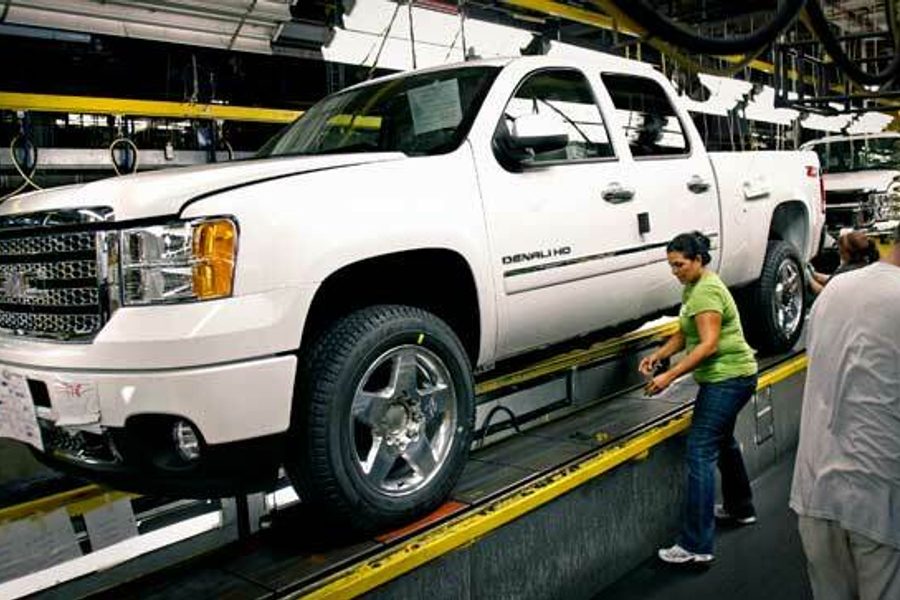Do New Fuel Efficiency Numbers Add Up?
Assessing Obama’s new fuel efficiency standards for vehicles sold in the U.S.
Ryan Williams

In the past two weeks, the Obama Administration has announced not one, but two new plans to address the fuel efficiency of new vehicles that will be built for sale in the U.S. between the years 2016 and 2025.
The first announcement was in regards to passenger vehicles. You might have missed it, because the mainstream media were all panicking about being crushed by the debt ceiling. With a few post-bailout auto industry executives and plenty of foreign car makers behind him, President Obama revealed that he had hammered together a plan to push the national passenger vehicle standards for fuel economy higher than they had ever been pushed before. He wanted 62 MPG, they wanted 45 MPG. A compromise was reached.
The first plan would set an average standard of 54.5 miles per gallon for all passenger vehicles manufactured and delivered to dealers (not sold to consumers) in model year 2025, 14 years in the future. The plan sets milestones of about 5% fuel efficiency improvement for new cars (about 3.5% for larger vehicles like trucks, minivans and SUVs) every year until the goal is achieved. The release came with a spiffy window-sticker style graphic, an impressive looking chart or two, and a fairly opaque ten page report (PDF) that provides good talking points on how families will save money and how much consumption the plan will eliminate, but cites only one source — from a Ford Motor Company press release.
Today, a second announcement was made, this time introducing similar regulations of greenhouse gas emissions and fuel efficiency for ‘medium and heavy duty vehicles.’ Commercial trucks, busses, cement mixers, delivery vans, and other large working vehicles. This second announcement didn’t receive any of the fanfare the first one did — it was relegated to a simple White House press release, along with announcements on the responsible parties’ websites. That’s because plan two is a little more complex, and a little less further along. Trucks aren’t built like cars: They can be the collaborative work of several companies, so it’s more difficult to find one responsible party to hold accountable for making improvements. For instance, a semi truck manufacturer can’t be accountable for the different weights of trailers truck drivers haul for different jobs.
Together, these plans promise to raise the average fuel efficiency of every new vehicle built for sale in the United States, sometime between 2016 and 2025. Both press releases were shipped out, chewed up and spit out by major newspapers. But almost nobody, certainly not the Washington Post, New York Times or Los Angeles Times asked a very important question: How will we be measuring this future success, exactly?
While there haven’t been any details released about the new plan for trucks and working vehicles, the portion of the plan that is aimed at passenger cars is the latest in a round of revisions to the Corporate Average Fuel Economy standards, known as CAFE. The new standards would carry over changes made to the program in 2007 and are designed to coincide with competing fuel economy timetables set in a 2002 California law. Adopting California’s stricter timetable nationwide would prevent automakers from having to meet two separate standards: one for California, and another for the rest of the country.
The first major reform to CAFE standards since they were created in 1975 came in 2007, when the Bush administration signed the Energy Independence and Security Act of 2007 into law. The 310 page legislation called for new collaboration between the Secretary of Energy (on behalf of the EPA) and Secretary of Transportation (on behalf of the NHTSA), and introduced new provisions for electric and hybrid vehicles, new standards for renewable fuel vehicles, the idea of a credit swapping system for makers of battery powered cars, and sponsored research for a new fuel efficiency standards for medium and heavy duty vehicles.. It also increased the CAFE average to 35 MPG by 2020. Those standards were then slightly (or historically, depending on who you believe) improved upon by Obama in 2010 to accelerate the 35 MPG timetable to 2016, and knock it up slightly to 35.5 MPG, and act on the recommendation for a separate plan for working vehicles. Regardless of the improvements made to the program, CAFE standards still suffer from a number of one-size-fits-all problems that can mislead consumers and the media alike.
CAFE standards are set by the National Highway Traffic Safety Administration (NHTSA), the same people that do recalls and crash test cars. Those standards are measured by the EPA, and automakers that fall short are fined. The standards were first established for passenger vehicles manufactured for model year 1978, in response to (this might sound familiar) instability in our national supply of gasoline and oil caused by the United States’ provision of arms to Israel during conflicts in the middle east. The CAFE program did manage to increase fuel economy between 1978 and 1987 (from 19.9 to 26.2 MPG), but it fell flat afterwards. Over the next two decades it would hover around 25 MPG, about 2 MPG lower than the standard. Attempts to reform the program came every few years from both sides of the aisle, but never made it past Congress, whose membership has been increasingly courted by the oil industry and the auto industry alike since the program began.
CAFE MPG estimates are largely measured by the auto manufacturers themselves (only 10-15% are verified by the EPA). Vehicles are tested in a laboratory dynamometer, a kind of treadmill for cars (the new truck standards will likely use these tests also). The tests can increase or decrease resistance to simulate different driving conditions, but do not include actual road tests. Until 2008, the tests also didn’t account for speeds in excess of 60 mph, low exterior temperature, or the use of gas-guzzling features like air conditioning, all factors that can have a significant impact on fuel economy. Those revisions were adopted even earlier, in 2006 (prior to Obama’s inauguration in January 2009), as the result of long-term advocacy by Bluewater Network (part of Friends of the Earth since 2005) and their work on a 2006 California law intended to reduce automobile carbon emissions by 30 percent by 2016. Fuel efficiency and carbon emissions are directly linked: The amount of carbon present in automobile exhaust is a direct indicator of how efficiently the engine burns fuel.
Even with the addition of new scenarios to test high speeds and cold starts, all tests still assume 45 percent highway and 55 percent city driving, and define highway driving as an average 48 MPH, with city driving as an average of 21 MPH with frequent stops. The tests range from 12 minutes to 31 minutes, but the new tests for high speed and air conditioning last just under 10 minutes. The tests do not account for the percentage of city drivers who sit for long periods idling in traffic, or common highway driving behaviors like driving in excess of posted speed limits. New tests proposed for working vehicles would include consideration for aerodynamic impact on gas mileage, but this data would likely be provided by manufacturers.
Because of the difficulty in accounting for every variation that can reduce an engine’s efficiency, CAFE results are mathematically ‘adjusted’ for real world conditions, sometimes by nearly 30%. So when the White House says we’re going to have a 54.5 MPG fleet by 2025, they’re creating massive, and perhaps intentional, confusion among the media and the public. In a real world scenario, a 54.5 MPG car would have a stated fuel economy closer to 48 MPG, and when you drove one of those new ‘54.5 MPG’ cars off the lot, it would probably get more like 35 MPG. The administration hasn’t even released figures on what standards working vehicles would need to meet, but in one report (PDF), semi trucks (the most common working vehicle) are asked to meet a 2017 voluntary goal of between 6.5 and 11.8 MPG, depending on their size and configuration. Those numbers will likely drop as well in an attempt to account for ‘real world’ conditions. Over-estimations of this kind are not new or unique to the Obama administration’s plan, but the plan so far does not address the issue, either.
The NHTSA stopped issuing annual fuel economy summary reports that detailed the program’s progress in 2004. In a similar but less detailed report released in April 2011 (PDF), CAFE averages seem to have increased the most in 2008, 2009, and 2010 — all years the report claims suffer from “incomplete data from the EPA.” That report also says that the average fuel economy for the fleet in 2011 is projected to be 29.3 MPG against a standard of 30.2 MPG. That would be a remarkable turnaround for a program that has hadn’t been able to meet its goals in the 30 years prior.
Further doubts of CAFE effectiveness are shown by auto sales tracking website TrueCar.Com. The company’s monthly True MPG report pegs the actual MPG average for all cars sold in the U.S. in June 2011 as a dismal 21.6 MPG. That figure is based on the same fuel economy data as the EPA’s projection, but measures actual sales through partnerships with data tracking agencies that report on monthly auto sales throughout the United States.
The reason the two reports disagree is partly because some auto makers, most notably Mercedes-Benz and BMW, refuse to comply with CAFE standards. Since 1983 (when fines were first established) Mercedes Benz and BMW have paid penalties almost every year (PDF). Instead of meeting regulatory standards, these and other auto makers opt to pay what some critics argue are fines so low ($55 per 1 MPG violation per car), that they represent only a microscopic penalty for the tens of millions of extra tons of CO2 these cars will emit during their lifetimes when compared with more efficient models. Penalties for violating CAFE have risen only 10 percent since 1983 while general inflation rose 119 percent during that time. In 2009, Mercedes Benz paid just under $3 million in penalties on worldwide revenues of $112.5 billion for missing the mark.
Another reason averages are dragged down is the number of car makers with truck and SUV heavy lineups, who some car makers claim use their larger passenger vehicles to cash in on exemptions designed to give breaks to those vehicles that toe the line between passenger and working class, like large pickup trucks. These types of exemptions have historically been applied to minivans and SUVs as well, allowing some auto makers to sell larger, less efficient vehicles and avoid paying penalties. Car makers, particularly foreign car makers who focus on smaller vehicles, see the new plan as continuing to favor American auto makers who focus on the sale of trucks and SUVs. Volkswagen, who has also paid fines as lately as 2007, has stated that the new regulations will unfairly forgive makers of large, less efficient vehicles and cause makers of smaller cars to reach higher individual benchmarks while allowing truck makers to exempt their least efficient vehicles by simply increasing their overall size.
With the historic difficulty in enforcing CAFE standards, progressive groups are cautiously optimistic. “This agreement is an important step forward, but there are still parts of the plan that need to be resolved,” Union of Concerned Scientists Clean Vehicles Program Director Michelle Robinson said in a statement regarding the passenger vehicle plan. “If they aren’t implemented correctly, they could turn into loopholes. If automakers can meet the standards with accounting tricks instead of using better technology, the program’s overall benefits would be eroded.”
At the Center for American Progress, Senior Fellow Dan Weiss praised the standards, but took issue with a key provision that allows auto makers to revise and possibly eliminate the plans goals following a “midterm review.” “This review is a self-destruct button that could enable auto companies to escape the most efficient standards, dramatically reducing relief for families,” he said in a statement. “It creates a perverse disincentive for automakers to innovate and improve efficiency because the less they achieve, the stronger their argument that the 2025 standard is technologically unachievable.”
That’s a salient point, given that BMW, one of the least fuel efficient auto makers to sign onto the new plan, said specifically in a July 27 letter that “the… mid-term evaluation described by the EPA and NHTSA… is critical, given BMW Group’s view of the uncertainty associated with the model years 2022-2025 standards.” Ford Motor Company produced a similar carefully worded statement in response to the new working vehicle rules, stating that they would only agree to a plan that “avoids unintended consequences.”
But what consequences (intentional or not) the plans will have is still an issue of debate — how the plans will work hasn’t yet been revealed. For the newly announced medium and heavy duty plan, there’s almost no information aside from a desire to increase fuel efficiency above the current norm. For the passenger vehicle plan, there’s the continued relaxation of rules for ‘light trucks’ (including SUVs and minivans) and how they will be classified, whether by drivetrain (the current system) or by a measurement of size (called the ‘footprint’ system) as well as a credit swapping system for alternative fuel vehicles (remember, this was introduced by the Bush administration) that some fear will create incentive for makers of larger vehicles like GM to flood dealer’s lots with ethanol burning vehicles, which haven’t significantly improved fuel economy but have significantly broadened the use of corn-based biofuel operations that detractors say encourage the growth of large-scale corn farming and contributes to nitrogen overloads in rivers and the growing lifeless ‘dead zone’ in the Gulf of Mexico.
Even if everything goes perfectly, replacing the 220 million cars and tens of millions of trucks and working vehicles on today’s roads will take decades from the enactment of new standards. The plans are, as some rightfully argue, a far better step towards energy independence and the reduction of harmful greenhouse gasses than what came before, which is to say 30 years of apathy on the part of policy makers and the auto industry. But after three decades of car makers actively resisting any increase in fuel economy standards, transparency and vigilance is required to test any claims of cooperation now.
So far, the plans make no mention of broader policies to incentivize drivers to reduce their personal gasoline consumption — only incentives for auto makers to produce fuel efficient cars and trucks with no guarantee of whether they will actually be purchased. The passenger plan appears as nothing more than this year’s update to CAFE, although how the working vehicles will be measured and regulated leaves some room for optimism.
Both plans toss numbers around suggesting the scale of the long-term economic and environmental benefit, but there’s no real quantifiable evidence for any of the supposed fuel savings listed in the plans — especially since they look so far into the future. The passenger press release says an average family will save more than $8,000 by “Obama administration standards,” but in the same report, those standards are clearly shown as being accurate to an earlier version of the plan that sought a 62 MPG increase in standards. There’s also no comparison of how much more a top-of-the-line fuel efficient car would cost, which could further whittle down the supposed household savings achieved.
While increasing fuel efficiency is a common sense victory for environmentalists, there is plenty of research that suggests that lowering the cost-per-mile of driving with higher fuel efficiency actually leads to more people driving, and offsets a percentage of the overall conservation effort. It remains to be seen whether these revisions will be used to leverage additional support for new freight and passenger railways or electric transportation infrastructure (both public and personal) needed to truly make a significant impact in our nation’s dependency on oil.
While the federal government is busy celebrating potential success 14 years in the future with misleading statistics and graphics, some states are working on establishing renewable, truly zero emission solutions today. In Illinois, Governor Pat Quinn recently signed two bills that will support the expansion of electric vehicles within car-sharing program I-GO. A private, not-for-profit agency spun off from the Center for Neighborhood Technology, I-GO will install 18 solar canopy charging stations to power a new fleet of 36 electric vehicles with zero tailpipe emissions, and no ‘upstream’ emissions produced by coal fired power plants needed to power them.
Car owners curious about comparing gas mileage can visit the EPA’s fueleconomy.gov. But if you are checking your own car, do yourself a favor: Bring a calculator and a notepad into your vehicle and record the mileage between trips to the gas station. Subtract the gallons you purchased from your total fuel capacity and divide the miles you’ve traveled by the gas you’ve burned. Compare the result to your car’s internal estimations (if equipped). The truth might surprise you.






